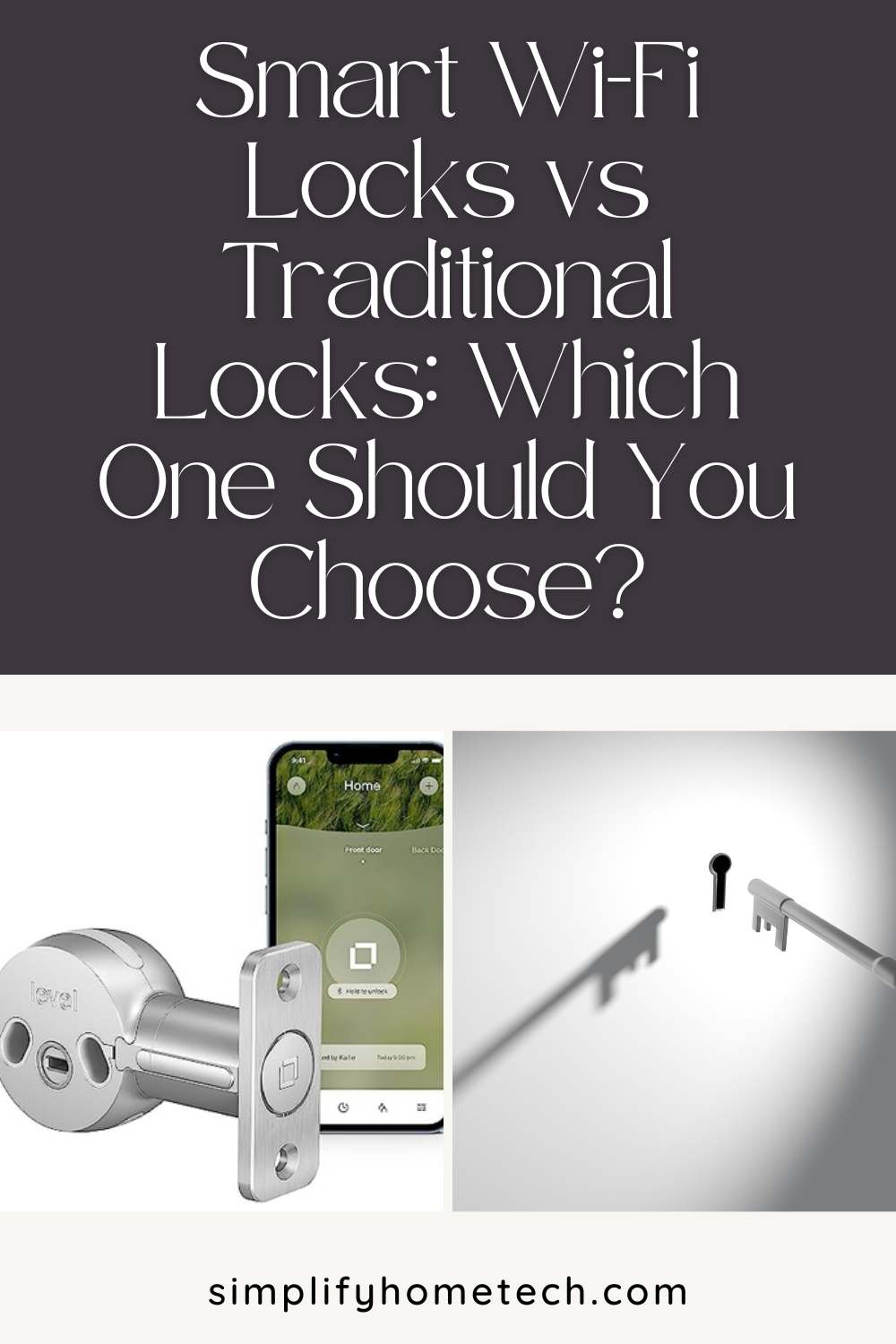Locks are essential devices for securing your home or office from unauthorized access. However, not all locks are created equal. With the advancement of technology, there are now two main types of locks available: smart Wi-Fi locks and traditional locks.
Smart Wi-Fi locks are innovative security devices that use wireless technology to connect to the internet and your smartphone. They allow you to lock and unlock your door remotely, create and share access codes, monitor activity history, and integrate with other smart home devices.
Traditional locks are mechanical security devices that use pins, tumblers, and keys to lock and unlock your door. They are simple and reliable, but they also have some limitations and drawbacks.
In this article, we will compare smart Wi-Fi locks vs traditional locks and help you decide which one is better for your needs. We will cover the following aspects:
- How smart Wi-Fi locks and traditional locks work
- The pros and cons of smart Wi-Fi locks and traditional locks
- The factors to consider when choosing between smart Wi-Fi locks and traditional locks
How Smart Wi-Fi Locks Work
Smart Wi-Fi locks are electronic locks that use Wi-Fi technology to communicate with your smartphone and the internet. They have a keypad or a touchscreen that allows you to enter a code or use your fingerprint to unlock your door. They also have a keyhole that allows you to use a physical key as a backup option.
Smart Wi-Fi locks can be controlled and managed through a mobile app on your smartphone. You can lock and unlock your door from anywhere, create and share temporary or permanent access codes with guests or service providers, view activity logs of who accessed your door and when, receive alerts and notifications of any unusual activity, and customize your lock settings.
Some smart Wi-Fi locks can also be integrated with other smart home devices, such as cameras, doorbells, lights, thermostats, and voice assistants. This allows you to create scenes and automation that make your home smarter and more secure. For example, you can set up a scene that turns on your lights, adjusts your thermostat, and plays some music when you unlock your door. Or you can set up an automation that locks your door, turns off your lights, and lowers your blinds when you leave home.
How Traditional Locks Work
Traditional locks are mechanical locks that use pins, tumblers, and keys to lock and unlock your door. They have a keyhole that requires a physical key to operate. They are simple and reliable, but they also have some limitations and drawbacks.
Traditional locks cannot be controlled or managed remotely. You need to have a physical key to access your door. If you lose your key or forget it inside, you may need to call a locksmith or break into your own home. You also cannot share access with others without giving them a copy of your key.
Traditional locks do not provide any activity history or alerts. You cannot monitor who accessed your door and when. You also cannot receive any notifications of any unusual activity or tampering attempts.
Traditional locks do not integrate with other smart home devices. You cannot create scenes or automation that make your home smarter and more secure. You also cannot use voice commands or other methods to control your lock.
Pros and Cons of Smart Wi-Fi Locks
Smart Wi-Fi locks have many advantages over traditional locks, but they also have some disadvantages. Here are some pros and cons of smart Wi-Fi locks:
Pros
- Convenience: Smart Wi-Fi locks allow you to lock and unlock your door without the need for physical keys, making it easier to manage access to your home.
- Remote access and control: With smart Wi-Fi locks, you can grant temporary or permanent access to family members, friends, or service providers from anywhere, using your smartphone or computer.
- Integration with smart home systems: Smart Wi-Fi locks can be seamlessly integrated with other smart home devices, enabling automation and enhancing security.
- Activity monitoring: Many smart Wi-Fi locks provide activity logs, allowing you to monitor who enters and exits your home and at what time.
- Enhanced security features: Smart Wi-Fi locks often come with advanced security features like fingerprint recognition, facial recognition, two-factor authentication, auto-locking, tamper alerts, etc.
Cons
- Power dependency: Smart Wi-Fi locks require power to function, either through batteries or wired connections. Battery-powered locks may need regular battery replacements.
- Vulnerability to hacking: As with any connected device, smart Wi-Fi locks are susceptible to hacking attempts, emphasizing the need for strong passwords and regular software updates.
- Compatibility and connectivity: Some smart Wi-Fi locks may not be compatible with all smartphones, routers, or smart home devices. They also depend on a stable Wi-Fi connection to work properly.
- Cost: Smart Wi-Fi locks are generally more expensive than traditional locks, and they may also require additional devices or subscriptions to access all their features.
Pros and Cons of Traditional Locks
Traditional locks have some advantages over smart Wi-Fi locks, but they also have some disadvantages. Here are some pros and cons of traditional locks:
Pros
- Reliability: Traditional locks are mechanical and do not rely on electricity or an internet connection to function. They are less likely to malfunction or fail due to power outages or connectivity issues.
- Simplicity: Traditional locks are easy to use and do not require any software or app updates. They also do not have any complex settings or features that may confuse some users.
- Security: Traditional locks are resistant to hacking attempts, as they do not use any wireless technology to communicate. They also do not store any personal data or information that may be compromised.
Cons
- Inconvenience: Traditional locks require physical keys to operate, which can be easily lost, stolen, or forgotten. They also do not allow you to share access with others without giving them a copy of your key.
- Lack of remote access and control: With traditional locks, you cannot lock or unlock your door from anywhere, nor can you grant or revoke access to others remotely. You also cannot receive any alerts or notifications of any activity or tampering attempts.
- Lack of integration with smart home systems: Traditional locks do not integrate with other smart home devices, nor can they be controlled by voice commands or other methods. They also do not provide any activity history or logs.
Factors to Consider When Choosing Between Smart Wi-Fi Locks and Traditional Locks
When choosing between smart Wi-Fi locks and traditional locks, there are several factors to consider, such as:
- Your budget: Smart Wi-Fi locks are generally more expensive than traditional locks, and they may also require additional devices or subscriptions to access all their features. If you have a limited budget, you may want to opt for a traditional lock instead.
- Your security needs: Smart Wi-Fi locks offer more security features than traditional locks, such as fingerprint recognition, facial recognition, two-factor authentication, auto-locking, tamper alerts, etc. If you have high-security needs, you may want to invest in a smart Wi-Fi lock instead.
- Your convenience preferences: Smart Wi-Fi locks offer more convenience than traditional locks, such as keyless entry, remote access, and control, integration with smart home systems, activity monitoring, etc. If you value convenience over anything else, you may want to choose a smart Wi-Fi lock instead.
- Your compatibility and connectivity: Smart Wi-Fi locks require compatible smartphones, routers, and smart home devices to work properly. They also depend on a stable Wi-Fi connection to function. If you have incompatible or unreliable devices or connections, you may want to stick with a traditional lock instead.
Conclusion
Smart Wi-Fi locks and traditional locks are two different types of security devices that have their advantages and disadvantages. Smart Wi-Fi locks offer more convenience, remote access, and control, integration with smart home systems, activity monitoring, and enhanced security features than traditional locks. However, they also require power, software, and connectivity, which means that they may malfunction or fail due to power outages, software glitches, or connectivity issues.
Traditional locks offer more reliability, simplicity, and security than smart Wi-Fi locks. However, they also require physical keys to operate, which can be easily lost, stolen, or forgotten. They also do not offer any remote access and control, integration with smart home systems, activity monitoring, or alerts.
When choosing between smart Wi-Fi locks and traditional locks, you need to consider your budget, security needs, convenience preferences, compatibility, and connectivity. Ultimately, the best choice depends on your personal preferences and needs.
We hope this article helped you understand the differences between smart Wi-Fi locks vs traditional locks and how to choose the best one for your home or office. If you have any questions or feedback, please let us know in the comments below.
You might also like,

